三年级英语my food教案1
小学英语《Unit3Whatsyourfavouritefood》教案:介绍儿童喜欢的食物

Possible article:Exploring Favorite Foods in Primary English ClassUnit 3 of the primary English textbook asks students to share their opinions about food and learn vocabulary related to different typesof cuisine. In this lesson plan, we will introduce some pedagogical activities that encourage children to talk about their favorite foods, practice basic sentence structures, and develop theircognitive and social skills.Objectives:-To enable students to communicate in English about their favorite foods using simple phrases and expressions-To enrich students' vocabulary and comprehension of food-related terms-To foster students' empathy and tolerance towards different food preferences and cultural backgrounds-To promote students' creativity and cooperation in designing and presenting their culinary creationsMaterials:-The textbook page with Unit 3 topic and vocabulary- A list of food-related questions and prompts-Pictures or samples of various foods (real or virtual)-Recipe cards or templates for a food-making activity (optional)-Feedback sheets for peer assessment (optional)Procedure:1.Warm-up: Food FlashcardsStart the lesson by showing some flashcards or images of different types of food, such as pizza, burger, sushi, noodles, chicken,carrot, apple, ice cream, etc. Ask the students to guess or name the food and tell whether they like it or not. You can also use a 5-star rating system to gather their opinions.2.Vocabulary Practice: Word AssociationUsing the vocabulary list from the textbook, ask the students to brainstorm words that are associated with food, such as taste, smell, texture, ingredients, utensils, cooking methods, etc. Write thewords on the board or on a mind map, and use them to elicit further examples from the students. You can also play a word chain game,where each student has to say a new word that starts with the last letter of the previous word.3.Speaking and Listening: Favorite Foods InterviewPair up the students and give them some interview questions to ask each other, such as:-What's your favorite food? Why do you like it?-Have you ever tried any foreign food? Which one did you like the most?-Do you prefer sweet or salty food? Hot or cold food? Spicy or mild food?-How do you usually eat your favorite food? With whom do you share it?Encourage the students to take turns asking and answering the questions, and to listen actively to their partner's answers. Youcan also provide some sentence patterns for them to use, such as:-My favorite food is ______. I like it because it tastes _______.-I haven't tried ______ before, but I'm curious about it.-I usually eat ______ for _______ meal. I share it with my _______.4. Writing and Reading: Food PoemAs a group activity, ask the students to brainstorm some adjectives that describe different foods, such as yummy, juicy, crunchy, burnt, sticky, sour, etc. Then, model a simple poem structure, such as: (Title) My Favorite Food(Line 1) (Food name) is _______ (adjective).(Line 2) It smells like _______ (noun).(Line 3) It feels _______ (adjective) in my mouth.(Line 4) I could eat it _______ (number) times a day.(Line 5) It reminds me of _______ (memory).Have the students work in pairs or small groups to create their own food poems, using the vocabulary and sentence structures they have learned. You can provide some examples or scaffolding sentences to help them, such as:-Pizza is cheesy and crispy.-It smells like fresh-baked bread.-It feels greasy and hot on my tongue.-I could eat it every day for a week.-It reminds me of my birthday party.5. Project and Presentation: Food FaceThis is a fun and creative art project that also involves some food decoration skills. Give each group a blank paper plate and someedible materials, such as fruits, vegetables, sauces, cheese, bread, etc. Explain that they have to design a face or a character usingthe food ingredients and present it to the class, explaining their choices and creativity. You can use some themes or challenges tomake it more engaging, such as:-Make a healthy food face.-Make a funny food face.-Make a traditional food face from your own culture.-Make a food face inspired by a famous person or character.After the presentations, ask the students to give feedback to each other, using some criteria such as creativity, effort, taste,variety, etc. You can also provide some reflective questions forthem to think about, such as:-How did you feel about making and sharing your food faces?-What did you learn from your classmates' presentations?-Did you discover any new favorite foods or combinations today?-How can you use English to talk about food in your daily life? Assessment:The students' performance can be assessed through various means,such as observation, participation, oral and written tasks, and peer feedback. You can use a rubric or a checklist that includes the learning objectives and some criteria for success, such as fluency, accuracy, vocabulary range, coherence, pronunciation, creativity, cooperation, etc.Conclusion:This lesson plan offers a variety of activities that cater todifferent learning styles and language skills. By exploring thetopic of favorite foods, students can enhance their communicative competence in English, broaden their cultural awareness, and develop their artistic and culinary abilities. Through collaborative and reflective tasks, students can also experience a sense of belonging and achievement in the classroom. The teacher's role is tofacilitate and scaffold the learning process, while encouraging and guiding the students to express themselves and learn from each other.。
湘鲁版小学英语三年级下册教案全册

Unit1 Welcome back!第1课时授课日期:教学目标1.用所学词语和句型讨论回校这个话题。
2.听懂会用所学句型welcome back!进行问答对话,掌握生词。
教学内容词汇:door open window close 句型:Good to see you again.Welcome back!教学过程1. warm up师:先前学过的句型hi, nice to meet you!开问生:Nice to meet you, too. 巩固和复习以前所学内容,并引出回校话题。
2.任务1(1)看look and listen的教学内容。
对话中出现了什么人物,他们在谈论什么,提到了哪些内容, 将有关生词写到黑板上。
(2)简单讲解黑板上的生词,教学生认读、跟读和记忆。
(3)播放录音。
先听两遍,让学生带着问题、带着目的去听。
(4)通过多种形式让学生朗读录音内容。
比如:跟录音读,跟教师读,角色扮演朗读。
(5)分小组角色扮演。
3.任务2(1)看listen,circle and say的教学内容带领学生朗读door open window close 这些单词。
(2)播放录音。
先让学生仔细听,注意动词。
(3)两人一组,仿照图片内容进行对话练习。
教学反思:第2课时授课日期:教学目标1.用所学词语和句型讨论回校话题。
2.听懂会用所学句型Good to see you again. 进行对话和交流。
教学内容句型:Good to see you again.Welcome back!教学过程1.任务3(1)看look, listen and try的教学内容。
浏览,了解大意和要求。
(2)播放录音。
先认真听两遍,听清人物的对话内容。
(3)两人一组,仿照图片内容进行对话练习。
2.任务4(1)看listen and tick的教学内容浏览,了解大意和要求。
(2)播放录音。
先认真听两遍,听清人物的对话内容。
(3)根据录音内容,选择正确的打钩。
三年级英语上册全册教案(冀教版三起)
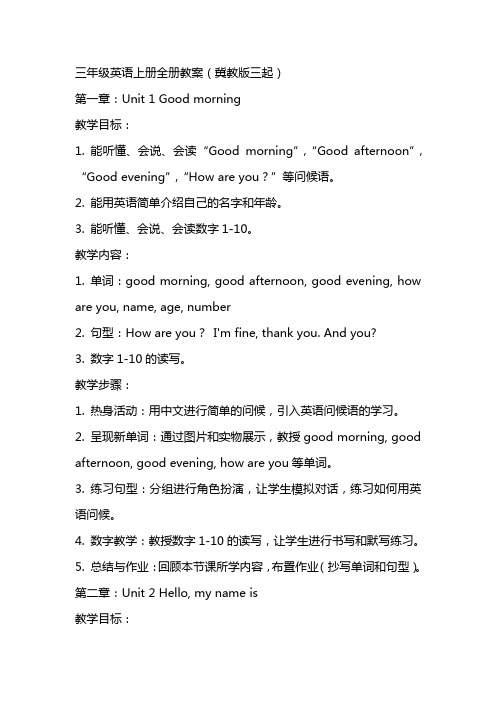
三年级英语上册全册教案(冀教版三起)第一章:Unit 1 Good morning教学目标:1. 能听懂、会说、会读“Good morning”,“Good afternoon”,“Good evening”,“How are you?”等问候语。
2. 能用英语简单介绍自己的名字和年龄。
3. 能听懂、会说、会读数字1-10。
教学内容:1. 单词:good morning, good afternoon, good evening, how are you, name, age, number2. 句型:How are you?I'm fine, thank you. And you?3. 数字1-10的读写。
教学步骤:1. 热身活动:用中文进行简单的问候,引入英语问候语的学习。
2. 呈现新单词:通过图片和实物展示,教授good morning, good afternoon, good evening, how are you等单词。
3. 练习句型:分组进行角色扮演,让学生模拟对话,练习如何用英语问候。
4. 数字教学:教授数字1-10的读写,让学生进行书写和默写练习。
5. 总结与作业:回顾本节课所学内容,布置作业(抄写单词和句型)。
第二章:Unit 2 Hello, my name is教学目标:1. 能听懂、会说、会读“Hello, my name is”,“What's your name?”等问候语。
2. 能用英语介绍自己的名字和年龄。
教学内容:1. 单词:hello, my name is, what's your name, age2. 句型:Hello, my name is What's your name?My name is How old are you?I'm years old.教学步骤:1. 热身活动:用中文进行简单的自我介绍,引入英语自我介绍的学习。
三年级英语上册全册教案(冀教版三起)
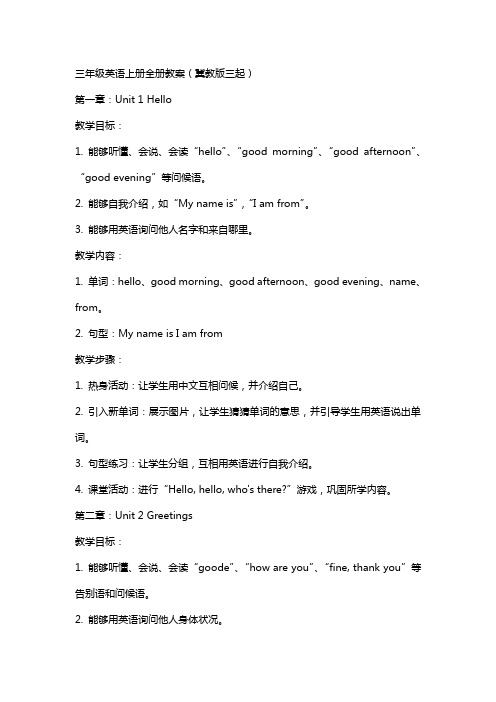
三年级英语上册全册教案(冀教版三起)第一章:Unit 1 Hello教学目标:1. 能够听懂、会说、会读“hello”、“good morning”、“good afternoon”、“good evening”等问候语。
2. 能够自我介绍,如“My name is”,“I am from”。
3. 能够用英语询问他人名字和来自哪里。
教学内容:1. 单词:hello、good morning、good afternoon、good evening、name、from。
2. 句型:My name is I am from教学步骤:1. 热身活动:让学生用中文互相问候,并介绍自己。
2. 引入新单词:展示图片,让学生猜猜单词的意思,并引导学生用英语说出单词。
3. 句型练习:让学生分组,互相用英语进行自我介绍。
4. 课堂活动:进行“Hello, hello, who's there?”游戏,巩固所学内容。
第二章:Unit 2 Greetings教学目标:1. 能够听懂、会说、会读“goode”、“how are you”、“fine, thank you”等告别语和问候语。
2. 能够用英语询问他人身体状况。
教学内容:1. 单词:goode、how are you、fine、thank you、ill、better。
2. 句型:How are you? I am fine, thank you. I am a little ill, but I am getting better.教学步骤:1. 复习上一单元的单词和句型。
2. 引入新单词:展示图片,让学生猜猜单词的意思,并引导学生用英语说出单词。
3. 句型练习:让学生分组,互相用英语询问身体状况。
4. 课堂活动:进行“How are you?”游戏,巩固所学内容。
第三章:Unit 3 Colors教学目标:1. 能够听懂、会说、会读“red”、“yellow”、“blue”、“green”等颜色单词。
最新三年级英语上册《Unit3MyFood》(Lesson13)1人教新起点优选教学课件

3.感受春天的微风轻抚最初萌芽的青草和树叶,把稚嫩的清香散播到四面八方。 4.酷热的夏天,享受一场豪雨和随之而来的凉爽、清新、草木苍翠。 5.在秋天火一样的红叶面前停下脚步,体味凋谢前最盛大的灿烂。
你很感激在这个世界上,有这样的一个人,他不在你的身边,他也并没有为你做些什么,你却希望,他会过的很好,长命百岁,子孙满堂,幸福安康……
你也很高兴有过那样的一份感情,纯净而又绵长,在这纷繁复杂的人世中,有这样的一个朋友,值得你去祝福,去思念……我都会想起以前的快乐。或许再美丽的语言,再美丽的往事,都及不上一次伤害来得深刻。伤口会慢慢结痂,变成一个坚硬的外壳,但是藏在这个坚硬外壳下的,还是一颗柔软的心。 夜深人静的时候听着清新流畅的音乐,像春天初融的雪花,纯净,沁凉,在茫茫的白消逝的时候,可以听到花开的声音。我沉静在这一尘不染的音乐中,可以忘却伤痛,抛开烦恼,回到最初的平静。还希望在这样的夜里,可以看到美丽的星空,一切让爱做主。我环顾周围的钓鱼者,一对父子引起我的注意。他们在自己的水域一声不响的钓鱼。父亲钓到、接着又放走了两条足以让我们欢呼雀跃的大鱼。儿子大概是12岁左右,穿着高筒橡胶防水靴站在寒冷的河水里。两次有鱼咬钩,但又都挣扎着跑脱了。突然,男孩的钓竿猛地一沉,差一点把他整个人拖倒,卷线轴飞快地转动,一瞬间鱼线被拉出很远。
蕊敏问她,数学成绩和暗恋相比哪个更重要些?还没有等亚宁回答,她自顾自地说了下去,上数学课的时候脑袋里乱七八糟的,不晓得装的是习题还是那个人。 亚宁长长地哦了一声,非常肯定地说,蕊敏,你也暗恋了!
蕊敏的眼泪吧嗒地落了下来,亚宁也哭了。两个人抱在一起,非常伤心。心里明白,暗恋是一件很难承受却又有小小欣喜的事。 因为这份心思,生活有了不同。确切地说,有了很奇怪的行迹。蕊敏和亚宁常在人群里交换一个莫名的眼神,蕊敏知道,亚宁在想那个人。她们喜欢独处,有了忧伤,会敏感,会发呆,会在下雨的时候写一些很酸的文字,也不再爱吃棒棒糖。而亚宁,在听见播音室传来的声音时,奉为天籁。
三年级英语my food教案4
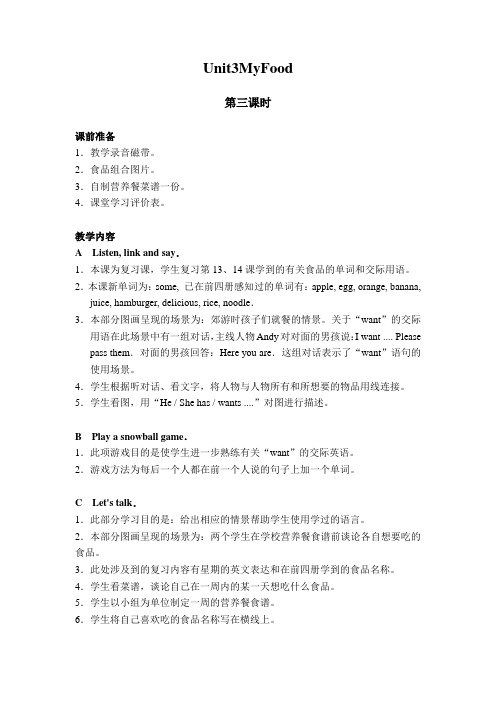
Unit3MyFood第三课时课前准备1.教学录音磁带。
2.食品组合图片。
3.自制营养餐菜谱一份。
4.课堂学习评价表。
教学内容A Listen, link and say.1.本课为复习课,学生复习第13、14课学到的有关食品的单词和交际用语。
2.本课新单词为:some, 已在前四册感知过的单词有:apple, egg, orange, banana, juice, hamburger, delicious, rice, noodle.3.本部分图画呈现的场景为:郊游时孩子们就餐的情景。
关于“want”的交际用语在此场景中有一组对话,主线人物Andy对对面的男孩说:I want .... Please pass them.对面的男孩回答:Here you are.这组对话表示了“want”语句的使用场景。
4.学生根据听对话、看文字,将人物与人物所有和所想要的物品用线连接。
5.学生看图,用“He / She has / wants ....”对图进行描述。
B Play a snowball game.1.此项游戏目的是使学生进一步熟练有关“want”的交际英语。
2.游戏方法为每后一个人都在前一个人说的句子上加一个单词。
C Let's talk.1.此部分学习目的是:给出相应的情景帮助学生使用学过的语言。
2.本部分图画呈现的场景为:两个学生在学校营养餐食谱前谈论各自想要吃的食品。
3.此处涉及到的复习内容有星期的英文表达和在前四册学到的食品名称。
4.学生看菜谱,谈论自己在一周内的某一天想吃什么食品。
5.学生以小组为单位制定一周的营养餐食谱。
6.学生将自己喜欢吃的食品名称写在横线上。
D Find and colour.1.此处为大小写字母配对练习。
2.学生看大写字母并在图中找出相对应的小写字母,并给小写字母涂上与该大写字母相同的颜色。
教学建议1.建议利用食品组合图片帮助学生复习有关食品的单词。
2.教师出示主线人物的图片,并贴在黑板上。
小学英语最新-三年级英语My food教案4 精品
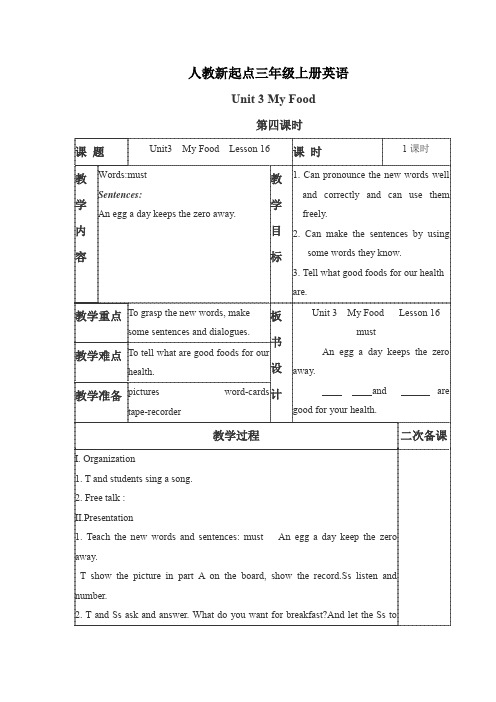
课
后
回
顾
G and P and T and V.
Come after B and C and D.
5. Fill in the blanks in Part D.
6. Show the small letters:
7. Write down the big letters in the book.
家
庭
作
业
1. Listen to the tape and read the text.
3. Ask the answer in pairs:
What do you want for breakfast/ lunch /supper/the picnic ?
I want….
4. Read the words in Part C.
B and C and D and G.
Come before P, T and V.
2. Can make the sentences by using some words they know.
3.Tell what good foods for our health are.
教学重点
To grasp the new words, make some sentences and dialogues.
板
书
设
计
Unit 3 My Food Lesson 16
must
An egg a day keeps the zero away.
andare good for your health.
教学难点
To tell what are good foods for our health.
冀教版小学英语第7册教案Unit6MyFood
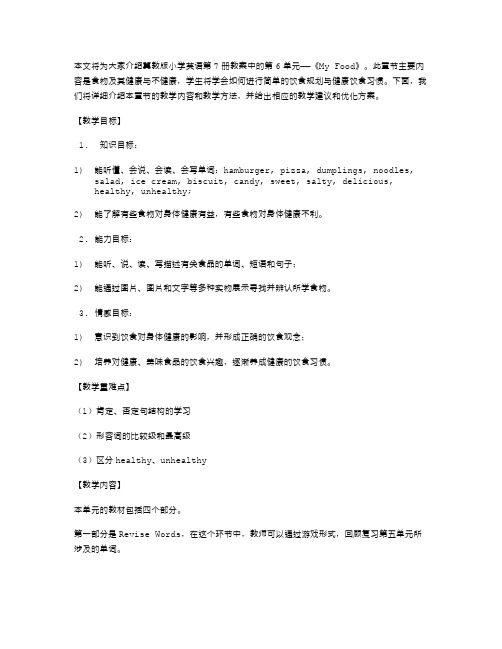
本文将为大家介绍冀教版小学英语第7册教案中的第6单元——《My Food》。
此章节主要内容是食物及其健康与不健康,学生将学会如何进行简单的饮食规划与健康饮食习惯。
下面,我们将详细介绍本章节的教学内容和教学方法,并给出相应的教学建议和优化方案。
【教学目标】1.知识目标:1)能听懂、会说、会读、会写单词:hamburger, pizza, dumplings, noodles,salad, ice cream, biscuit, candy, sweet, salty, delicious,healthy, unhealthy;2)能了解有些食物对身体健康有益,有些食物对身体健康不利。
2. 能力目标:1)能听、说、读、写描述有关食品的单词、短语和句子;2)能通过图片、图片和文字等多种实物展示寻找并辨认所学食物。
3. 情感目标:1)意识到饮食对身体健康的影响,并形成正确的饮食观念;2)培养对健康、美味食品的饮食兴趣,逐渐养成健康的饮食习惯。
【教学重难点】(1)肯定、否定句结构的学习(2)形容词的比较级和最高级(3)区分healthy、unhealthy【教学内容】本单元的教材包括四个部分。
第一部分是Revise Words,在这个环节中,教师可以通过游戏形式,回顾复习第五单元所涉及的单词。
第二部分是New Words,在这部分教材中,将为学生介绍七个食物的名称及形容词(hamburger, pizza, dumplings, noodles, salad, ice cream, biscuit, candy, sweet, salty, delicious, healthy, unhealthy)。
第三部分是Drill。
在这个环节中,通过朗诵、表演等方式,培养学生的口语表达能力,提高学生的英语语感和口语表达能力。
第四部分是Exercise。
这个部分是本节课的重要部分,包括学生完成课本练习,以及教师设计的练习等。
Unit3Food(教案)人教新起点版英语三年级上册

Unit 3《Food》第一课时教案教学目标1.能够听说读写本课有关食物的单词。
2.能够用英文提问并回答对某种食物是否喜欢。
3.元音字母i在闭音节中的发音规律及单词的书写与记忆。
教学重点1.本课重点单词.2.字母i在闭音节中的发音规律及单词的书写与记忆。
教学难点1.本课重点单词。
2.字母i在闭音节中的发音规律及单词的书写与记忆。
课前准备1.教学录音磁带。
2.食物卡片。
3.教学课件。
4.课堂学习评价表。
课时安排1课时教学过程一、Warmingup1.播放第二单元的歌曲,进入本课课堂。
2.教师播放学过的食物图片rice, noodles, fish,chicken,egg,引入Food的话题。
二、Presentation1.师:今天我们要学习一些新的食物名称了,我们一起到超市看一看吧。
2.听录音,学生跟读单词。
3.教师领读,边领读边把单词写在黑板上。
4.根据音标读单词:cake蛋糕[keɪk] bread面包[bred] icecream冰淇淋['aɪskri:m] meat肉[mi:t] potato土豆[pəˈteɪtəʊ] tomato西红柿[təˈmɑ:təʊ] fruit水果[fru:t] 土豆和西红柿两个词一般用复数形式,其复数就是在单词后加es. 读音为[z].三、Pair work学生自编歌谣读单词:蛋糕cake香又甜,面包bread软绵绵,,,,可以让学生自由发挥,同桌两人相互说一说。
四、Let’s talk1.教师示范,手拿一张食物卡片:Do you like icecream?引导学生肯定回答为:Yes, I do.否定回答为:No,I don’t.2.学生手拿食物图片,二人为一组进行调查活动。
在课本上打上对或错。
五、Let’s write1.出示食物单词卡,教师边读边写在黑板上的四线三格里。
2.学生书写单词,教师在班内走动查看,对书写不规范的及时纠正。
六、Let’s spell1.播放录音,学生边跟读边指出单词,体会字母i的发音规律。
三年级英语上册 Unit 3 My Food(lesson16-18)教案 人教新起点(2021学

三年级英语上册Unit 3 My Food(lesson16-18)教案人教新起点编辑整理:尊敬的读者朋友们:这里是精品文档编辑中心,本文档内容是由我和我的同事精心编辑整理后发布的,发布之前我们对文中内容进行仔细校对,但是难免会有疏漏的地方,但是任然希望(三年级英语上册Unit 3 My Food(lesson16-18)教案人教新起点)的内容能够给您的工作和学习带来便利。
同时也真诚的希望收到您的建议和反馈,这将是我们进步的源泉,前进的动力。
本文可编辑可修改,如果觉得对您有帮助请收藏以便随时查阅,最后祝您生活愉快业绩进步,以下为三年级英语上册Unit 3My Food(lesson16-18)教案人教新起点的全部内容。
Unit 3My FoodLesson16教学内容:1.P26A2.P27B: Ask and answer。
3.P27 C:Listenand chant.D:Put in themissing lettes.教学目标:通过学习英文小故事,你从中学到了什么?对!吃早餐有益于身体健康。
教学重点:通过学习英文小故事,懂得早餐对身体健康很重要。
教学用具:录音机,磁带,铅笔,单词卡片。
教学过程:你们好,今天我们谈一谈和生活习惯有关的话题,你能猜一猜是什么话题吗?对!和饮食有关。
(I eat breakfast every dy。
Do you eatbreakfasteveryday?If not。
I think you’dbetter eat breakfasteveryday。
It’s good f or your health. )我每天都吃早餐,你每天吃早餐吗?如果不是,我想你最好每天吃早餐。
对你的健康有好处。
一、1.请你把书打开翻到26页,带着以下几个问题去看A部分:What timeisit? Where idhegoing? Does he eatbreakfast? What's the matterwith him? What does the teacher say? Does he want a zero?(现在是几点?他去哪儿了?他吃早餐了吗?他怎么了?老师对他说了些什么?他想得零分吗?)2.看完了吗?现在请你听录音,给图片排列顺序。
新起点三年级英语上册教案设计《My Food》

The teacher shows the picture of carrot and teach it. Then show the picture of carrots, carrot carrots .
Next teach the words tomato, meatball, sausage. tomato tomatoes meatball meatballs, sausage sausages
教学重点:
Be able to know well the new words: food fridge carrot tomato meatball sausage
教学难点:
Be able to understand and use the sentences: What do you have in your fridge? I have 。
教具准备:
recorder tape slides
新起点三年级英语上册教案设计《My s the picture of fridge and teach it. Spell and read one by one or each other. Show the sentence: What do you have in your fridge? The students read it .Now look at my fridge :
新起点三年级英语上册教案设计《My Food》
新起点三年级英语上册教案设计《My Food》
1. Be able to know well the new words: food fridge carrot tomato meatball sausage
2.Be able to understand and use the sentences: What do you have in your fridge? I have 。
人教版新起点小学英语三年级上册unit3myfood教案

Lesson 13课前准备1.教学录音磁带。
2.各类食物的组合图片。
3.单词图片和卡片(师生各自准备)。
4.食物贴画(学生准备)。
5.字母卡片(师生各自准备)。
6.课堂学习评价表。
教学内容A Look, listen and chant.1.本课通过歌谣引入有关食物单词的学习。
本课的新单词为:food, fridge, beef, bread, sausage, meatball, pancake, sandwich, tomato, potato, carrot, mantou.本课学生曾经在一至四册感知过的单词有:chicken, milk.2.本部份图画呈现的场景为一个打开的冰箱,冰箱里贮存着各类食物。
这一情景与实际生活较接近,因学生有必然的生活经验,接受起来比较容易。
3.本部份学习重点是感知有关食物的单词。
4.关于可数和不可数名词仅给学生一个模糊概念,不要给学生讲过量的语法,因为学生年龄小,不睬解也记不住。
讲到什么程度视学生的接受能力,若是学生不能接受,只要记住具体的词在表达复数的时候是不是加s即可。
5.在所学过的食物单词中,不可数名词有:beef, bread, mantou, rice, jiaozi, tofu, meat, milk, fish, chicken, juice, water.在可数名词中词尾加s后发生转变的词有:sandwiches / iz / , tomatoes / z / , potatoes / z / .特别要注意单数名词变成复数名词后词尾的发音, 如sausages / iz / , carrots / ts / 等。
B Stick and ask.1.本部份为A项的巩固练习。
2.本部份图画呈现的是一个空冰箱,学生将食物的贴画贴在冰箱里,然后两人一组询问对方冰箱里有什么。
3.本部份学习重点是熟练有关食物的单词。
4.本部份学习难点是有关食物的单词的认读和记忆。
小学新课标三年级上Unit3MyFood教案
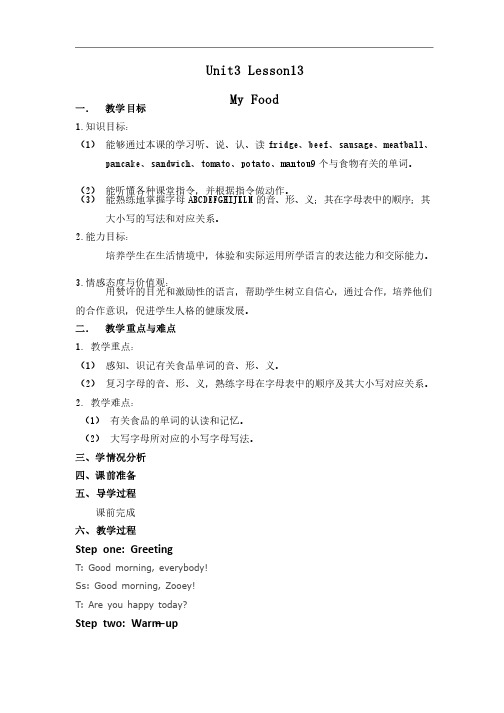
Unit3 Lesson13My Food一. 教学目标1.1.知识目标:知识目标:知识目标:(1) 能够通过本课的学习听、说、认、读fridge fridge、、beef beef、、sausage sausage、、meatball meatball、、pancake pancake、、sandwich sandwich、、tomato tomato、、potato potato、、mantou9个与食物有关的单词。
个与食物有关的单词。
(2) 能听懂各种课堂指令,并根据指令做动作。
(3) 能熟练地掌握字母ABCDEFGHIJKLM 的音、形、义;其在字母表中的顺序;其大小写的写法和对应关系。
大小写的写法和对应关系。
2.2.能力目标:能力目标:能力目标:培养学生在生活情境中,体验和实际运用所学语言的表达能力和交际能力。
3.3.情感态度与价值观:情感态度与价值观:情感态度与价值观: 用赞许的目光和激励性的语言,用赞许的目光和激励性的语言,帮助学生树立自信心,帮助学生树立自信心,帮助学生树立自信心,通过合作,通过合作,通过合作,培养他们培养他们的合作意识,促进学生人格的健康发展。
二. 教学重点与难点1.1. 教学重点:教学重点:(1) 感知、识记有关食品单词的音、形、义。
(2) 复习字母的音、形、义,熟练字母在字母表中的顺序及其大小写对应关系。
2.2. 教学难点:教学难点:(1) 有关食品的单词的认读和记忆。
有关食品的单词的认读和记忆。
(2) 大写字母所对应的小写字母写法。
大写字母所对应的小写字母写法。
三、学情况分析四、课前准备五、导学过程课前完成课前完成六、教学过程 Step one: GreetingT: Good morning, everybody!Ss: Good morning, Zooey!T: Are you happy today?Step two: Warm —upT: OK, first let’s sing a song.. “I like to eat; I like to eat......”(Ss sing the song with clapping hands)T:Now this time let’s play a guessing game!猜食品Good job!Step three: Lead inT: After playing game, I feel a little hungry.Are you hungry? I want to eat some food.Look, I have a big...... (Put a fridge on the blackboard)What is it?Yes, I have a big fridge! Can you guess what’s in it?L et’s learn Unit 3My Food. (Write the title on the blackboard) Step four: We can win1.I can read the new words泛读,开火车,分组; (出示新单词,找人带读单词并讲解学习技巧归类,获得单词卡) 教师带领复习循环记;TPR;拍手3.Listen and point 师生;生生;4.Other word 解决难题,教师指导5.Chant 听指;听说Step five: We can talk PartB1.我跟老师学句型:What do you have in your fridge? 2.看图,说句子,我能行(看Lily、Bill和Zooey家冰箱)3.小小统计员(每组一张统计单,通过调查形式统计出最爱吃的食物)Step Six:We can show情景创设:飞机和餐馆运用句型:What do you have in your memu? Step Seven: Fill in the small letters1.Song of le ers 2.生活中的字母3.Fill in the small le ers 4.Check the answer together Step Eight:homework 1.评价单2.画一画,生活中你最喜欢的食物3.Letter一个一行。
冀教版小学三年级英语下册教案全册

Lesson 1 I’m Hungry!一、教学目标:知识目标1、要求学生掌握下列单词eat、drink、table、food2、能理解并能口头运用句子 I’m (hungry/thirsty)。
I want to (eat/drink);能力目标:能够在真实的环境中表达自己的需求。
情感目标:初步了解中西方饮食差异,注意饮食卫生及营养。
二、教学重点和难点:本课的四个单词和句子。
三、教具:录音机和磁带,手偶,教师用卡片和张贴画,实物,奖励用的金星。
四、学具:学生用小卡片。
五、教学过程:Step 1、(1)Greeting: Hello, boys and girls! How are you today ?(2)师生同唱“I Love You”,(可以边做动作边唱)Step 2、引入课题:用张贴画出示本课主题图,引导学生:Who are they? 学生可以说出一些家庭成员的身份,(比如daughter, father, mother, son).What are they doing?学生可以用汉语回答,从而引出本课要学的有关饮食的内容。
(板书课题:Lesson 1)Step 3、利用卡片出示桌子,放录音。
学生模仿读音,找同学领读,分组读。
依次学习food ,eat ,drink,(在学习eat ,drink时教师可以加上动作,板书eat ,drink)鼓励发音不标准的学生多练习几遍,至读音标准。
采用多种形式全班练习,利用小卡片组长组织练习,直至读熟。
Step 4、Game:(1)Quickly answer.(快速抢答)(2)Guessing words.(猜单词)Step 5、Practice in groups(小组之内组长组织练习上面游戏)。
Step 6、Demonstrate: (Introduce: want)T: I want a pencil. I want a pencil .May I have a pencil? I want a book,say together, class!Ss: I want a book.(Learn to say: want)Step 7、(板书I want to…)Use actions to demonstrate the new phrases。
小学英语人教新起点三年级上册Unit3Food人教版小学英语三年级上册Unit3教学设计

人教版小学英语三年级上册Unit 3 My Food教学设计Lesson 1教学内容:P22 A Look, listen and chant ;B Stick and ask:C Put in the missing letters.教学目标:1.A Look,listen and chant;2.B Stick and ask;3.C Put in the missing letters.教学重点:1.感知和熟悉有关食品的单词。
2.填出所缺字母,熟练字母在字母表中的顺序。
教学用具:录音机,磁带,食品单词卡片,字母卡片,贴画。
教学过程:在我们上课之前请你把学习用具准备好。
好吧!现在咱们开始上课吧。
一、首先请你回答老师一个问题,我们通常把食品,蔬菜和饮料放在什么地方?对!放在冰箱(fridge)里,现在请你把书打开翻到P22,看一看,听一听你的冰箱里有些什么?噢!你冰箱里的食品可真不少,那你能用英语说出这些食品的名称吗?也许现在还说不出来或是能说上几个,但老师相信你学完这课书的时候一定能把你冰箱里的食品用英语说出来。
现在请你再听一听P22A部分的录音,在听的同时,你不但要充分利用【设计意图】:通过师生间的日常问候,引导学生进入英语思维的课堂环境,歌曲、游戏的出现,引导学生巩固人体器官、文化用品等单词,为后面相关内容的出现打下基础。
2、新课呈现(1)教师让一学生扮演“变色龙”,介绍单词:red,green.T: Today is my friend’s birthday, he is very happy. Look,He is coming!S1:Hello!Dear friends!Ss:Hello!T:What’s your name?S1:My name is ChameleonT:Hi,Chameleon. What can you do?S1:I can change colours.Look!I’m RED.(Turn around) Now, I’m GREENSs:Wow!注:S1为一学生,Ss指全班同学,T为教师.(2)教师在黑板上画出彩色气球,边画边说单词。
三年级英语上册Unit3MyFood(lesson17)教案人教新起点
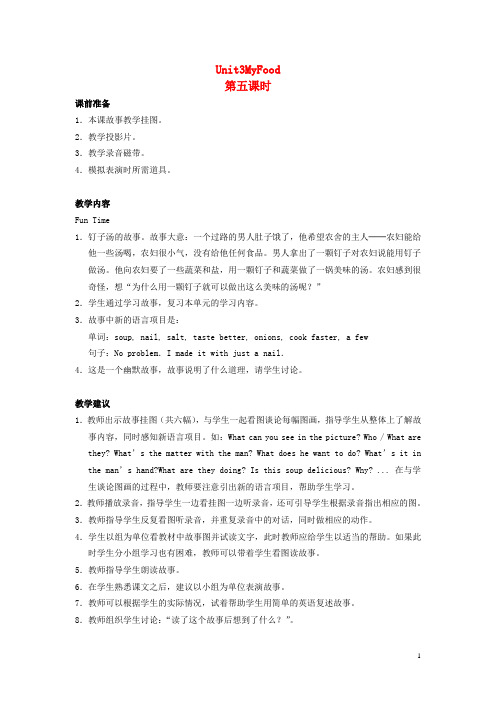
Unit3MyFood第五课时课前准备1.本课故事教学挂图。
2.教学投影片。
3.教学录音磁带。
4.模拟表演时所需道具。
教学内容Fun Time1.钉子汤的故事。
故事大意:一个过路的男人肚子饿了,他希望农舍的主人──农妇能给他一些汤喝,农妇很小气,没有给他任何食品。
男人拿出了一颗钉子对农妇说能用钉子做汤。
他向农妇要了一些蔬菜和盐,用一颗钉子和蔬菜做了一锅美味的汤。
农妇感到很奇怪,想“为什么用一颗钉子就可以做出这么美味的汤呢?”2.学生通过学习故事,复习本单元的学习内容。
3.故事中新的语言项目是:单词:soup, nail, salt, taste better, onions, cook faster, a few句子:No problem.I made it with just a nail.4.这是一个幽默故事,故事说明了什么道理,请学生讨论。
教学建议1.教师出示故事挂图(共六幅),与学生一起看图谈论每幅图画,指导学生从整体上了解故事内容,同时感知新语言项目。
如:What can you see in the picture? Who / What are they? What’s the matter with the man? What does he want to do? What’s it in the man’s hand?What are they doing? Is this soup delicious? Why? ... 在与学生谈论图画的过程中,教师要注意引出新的语言项目,帮助学生学习。
2.教师播放录音,指导学生一边看挂图一边听录音,还可引导学生根据录音指出相应的图。
3.教师指导学生反复看图听录音,并重复录音中的对话,同时做相应的动作。
4.学生以组为单位看教材中故事图并试读文字,此时教师应给学生以适当的帮助。
如果此时学生分小组学习也有困难,教师可以带着学生看图读故事。
5.教师指导学生朗读故事。
2023年最新人教版三年级上册英语全册教案(全册)

2023年最新人教版三年级上册英语全册教案(全册)Unit 1: Hello!- Lesson 1: Greetings- Class activities:- Sing the song "Hello, Hello!"- Watch a short video about greetings.- Practice greetings with a partner.- Homework:- Review the greetings learned in class.- Write a short paragraph about how you greet people in your daily life.- Lesson 2: Introductions- Objective: To learn how to introduce oneself and ask for someone's name.- Class activities:- Introduce yourself to the class.- Practice introducing yourself and asking for names in pairs.- Play a game of "Guess Who" using English introductions.- Homework:- Write a dialogue between two friends introducing themselves and asking for each other's names.Unit 2: My Family- Lesson 1: Family Members- Objective: To learn the names of family members in English.- Class activities:- Show pictures of family members and teach their names in English.- Practice saying the names with gestures.- Play a memory game with family member cards.- Homework:- Draw a picture of your family and label each member with their name in English.- Write sentences describing your family members.- Lesson 2: My Family Tree- Objective: To learn how to talk about family relationships using "is" and "are."- Class activities:- Show a family tree diagram and explain the relationships.- Practice making sentences about family members using "is" and "are."- Create a class family tree together.- Homework:- Interview a family member and ask about their relationship with other family members.- Write a short paragraph describing your family tree.Unit 3: School Life- Lesson 1: Classroom Objects- Class activities:- Show flashcards of classroom objects and teach their names in English.- Practice saying the names and spelling them.- Play a game of "What's Missing?" with classroom objects.- Homework:- Take a picture of your classroom and label the objects in English.- Write sentences describing your favorite classroom objects.- Lesson 2: Daily Routines- Objective: To learn how to talk about daily routines using present simple tense.- Class activities:- Practice making sentences about daily routines.- Create a class daily routine schedule.- Homework:- Keep a diary for three days, writing about your daily routines in English.- Write a short paragraph about your favorite daily routine.Unit 4: My Home- Lesson 1: Rooms in a House- Objective: To learn the names of rooms in a house in English.- Class activities:- Show pictures of rooms in a house and teach their names in English.- Practice saying the names and identifying the rooms.- Play a game of "Find the Room" using room flashcards.- Homework:- Draw a map of your home and label the rooms in English.- Write sentences describing your favorite room.- Lesson 2: Furniture and Objects- Objective: To learn the names of furniture and objects in a house in English.- Class activities:- Show flashcards of furniture and objects and teach their names in English.- Practice saying the names and matching them to the correct room.- Play a memory game with furniture and object cards.- Homework:- Take a picture of your favorite piece of furniture and write a paragraph about it in English.- Write sentences describing objects you can find in different rooms.Unit 5: Food and Drinks- Lesson 1: Food- Class activities:- Show flashcards of food items and teach their names in English.- Practice saying the names and categorizing them into groups.- Play a guessing game with food flashcards.- Homework:- Create a menu with different food items and their names in English.- Write a short paragraph about your favorite food.- Lesson 2: Drinks- Class activities:- Show pictures of drinks and teach their names in English.- Practice saying the names and discussing preferences.- Create a class drink survey and analyze the results.- Homework:- Take a picture of your favorite drink and write a paragraph about it in English.- Write sentences describing drinks you like or dislike.---*Note: This curriculum plan is based on the 2023 edition of the people's education press for the third grade. The content may vary depending on the specific edition used.*。
我最喜欢的中国传统食物英语作文全英教案
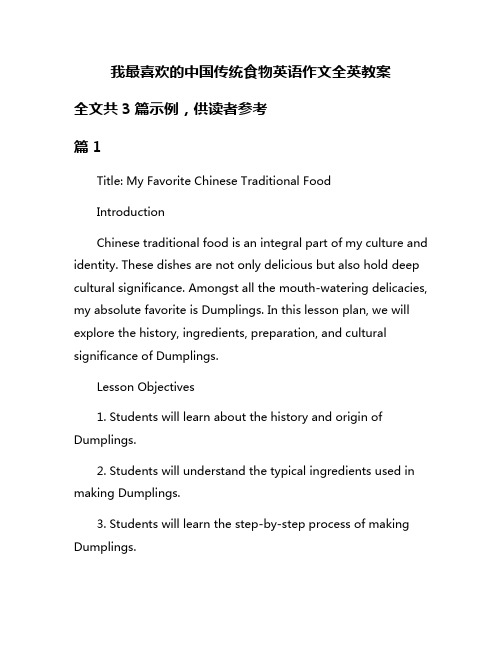
我最喜欢的中国传统食物英语作文全英教案全文共3篇示例,供读者参考篇1Title: My Favorite Chinese Traditional FoodIntroductionChinese traditional food is an integral part of my culture and identity. These dishes are not only delicious but also hold deep cultural significance. Amongst all the mouth-watering delicacies, my absolute favorite is Dumplings. In this lesson plan, we will explore the history, ingredients, preparation, and cultural significance of Dumplings.Lesson Objectives1. Students will learn about the history and origin of Dumplings.2. Students will understand the typical ingredients used in making Dumplings.3. Students will learn the step-by-step process of making Dumplings.4. Students will explore the cultural significance of Dumplings in China.Warm-up ActivityBegin the lesson by asking students if they have ever tried Dumplings before. Encourage students to share their experiences and thoughts on this dish. Show pictures of different types of Dumplings and ask students to describe what they see.History and Origin of DumplingsDumplings have a long history in Chinese cuisine, dating back to over 1,800 years ago. Legend has it that Dumplings were created by the famous Chinese physician Zhang Zhongjing during the Han Dynasty. He made a medicine-filled water dough into small packages to keep his patients warm during winter. Over time, this medicinal food evolved into the delicious Dumplings we know today.Ingredients for Making Dumplings1. Dumpling wrappers: made from wheat flour and water, these thin dough sheets are used to encase the filling.2. Filling: commonly made with a combination of minced meat (pork, chicken, or beef), vegetables (cabbage, carrots, andchives), and seasonings (soy sauce, ginger, garlic, and sesame oil).3. Dipping sauce: a mixture of soy sauce, vinegar, sesame oil, and chili paste for added flavor.Preparation of Dumplings1. Prepare the filling by mixing the minced meat, finely chopped vegetables, and seasonings in a bowl.2. Place a small amount of filling in the center of a dumpling wrapper.3. Moisten the edges of the wrapper with water and fold it in half to seal the dumpling.4. Crimp the edges of the dumpling to create a decorative pattern.5. Boil, steam, or pan-fry the dumplings until cooked.6. Serve hot with dipping sauce.Cultural Significance of DumplingsDumplings play a significant role in Chinese culture, especially during special occasions like Chinese New Year. In Chinese tradition, Dumplings symbolize wealth and prosperity,as their shape resembles ancient Chinese currency. Families come together to make and eat Dumplings as a way to bond and celebrate the new year.ConclusionDumplings are more than just a delicious food; they are a symbol of love, tradition, and togetherness in Chinese culture. By learning about the history, ingredients, preparation, and cultural significance of Dumplings, we gain a deeper appreciation for this iconic Chinese dish. As you enjoy your next plate of Dumplings, remember the rich history and meaning behind each bite.篇2My Favorite Traditional Chinese FoodI. IntroductionA. Topic: My Favorite Traditional Chinese FoodB. Objectives:1. To introduce traditional Chinese food2. To share personal favorite dishes3. To discuss the significance of traditional food in Chinese cultureC. Procedures:1. Introduction to traditional Chinese food2. Sharing personal favorite dishes3. Discussion on the significance of traditional food in Chinese cultureII. Introduction to Traditional Chinese FoodA. Traditional Chinese cuisine is known for its diversity, flavors, and importance in Chinese culture.B. Key ingredients in Chinese cooking include rice, noodles, vegetables, and various meats such as pork, chicken, and fish.C. Common cooking techniques in Chinese cuisine include stir-frying, steaming, and braising.III. Sharing Personal Favorite DishesA. My favorite traditional Chinese dish is Kung Pao Chicken.1. Ingredients: chicken, peanuts, vegetables, and a spicy sauce2. Cooking method: stir-frying3. Flavor profile: savory, spicy, and slightly sweetB. Another favorite dish of mine is Dim Sum.1. Dim Sum is a type of Chinese brunch involving small portions of various dishes such as dumplings, spring rolls, and buns.2. Dim Sum is typically enjoyed with tea and is a social dining experience.C. I also enjoy Hot Pot, a popular Chinese cooking method where ingredients are cooked in a simmering pot of broth at the dining table.1. Ingredients: a variety of meats, seafood, vegetables, and noodles2. Hot Pot is a popular choice for gatherings and celebrations in China.IV. Significance of Traditional Chinese Food in Chinese CultureA. Traditional Chinese food plays a significant role in Chinese culture, reflecting the country's history and regional diversity.B. Food is an important aspect of Chinese social gatherings, festivals, and celebrations.C. Traditional Chinese food has also been influenced by various philosophical beliefs and practices such as Yin-Yang balance and the concept of qi.V. ConclusionA. Traditional Chinese food is an essential part of Chinese culture, reflecting the country's history, diversity, and social customs.B. By sharing and enjoying traditional Chinese dishes, we can appreciate and preserve the rich culinary heritage of China.C. I hope this lesson has inspired you to explore and savor the delicious flavors of traditional Chinese cuisine. Thank you for joining me in this culinary journey!篇3Title: My Favorite Traditional Chinese FoodIntroductionHave you ever tried traditional Chinese food? Chinese cuisine is one of the most diverse and delicious in the world. Today, I would like to share with you my favorite traditional Chinese food and why I love it so much.BackgroundChinese cuisine has a long history and a rich variety of flavors. From spicy Sichuan dishes to delicate Cantonese dim sum, there is something for everyone to enjoy. My favorite Chinese food comes from the northern region, known for its hearty and flavorful dishes.My Favorite Chinese FoodMy favorite Chinese food is Peking Duck. Peking Duck is a famous dish from Beijing, known for its crispy skin and tender meat. The duck is roasted in a special oven until the skin is golden brown and crispy, then thinly sliced and served with pancakes, hoisin sauce, and scallions.Why I Love ItThere are several reasons why Peking Duck is my favorite Chinese food. First, the combination of crispy skin and tender meat creates a delicious contrast in texture. The rich flavor of the duck pairs perfectly with the sweet hoisin sauce and crunchy scallions. Additionally, the presentation of Peking Duck is beautiful, making it a perfect dish for special occasions.Where to Find ItIf you ever have the chance to visit Beijing or a Chinese restaurant that specializes in Peking Duck, I highly recommendtrying it. The experience of watching the chef carve the duck tableside and assemble the pancakes is unforgettable. Peking Duck is a true culinary delight that everyone should try at least once.ConclusionIn conclusion, Peking Duck is my favorite traditional Chinese food because of its delicious flavor, unique texture, and beautiful presentation. Chinese cuisine is full of amazing dishes like Peking Duck, waiting to be discovered and enjoyed. I hope you have the opportunity to try Peking Duck and experience the joy of traditional Chinese cuisine. Thank you for reading!。
三年级英语my food教案5

Unit3MyFood第四课时课前准备1.A项教学挂图。
2.教学录音磁带。
3.字母卡片(教师和学生各自准备)。
4.单词卡片。
5.学生评价表格。
教学内容A Listen, think and number.1.本部分为生理卫生学科融合。
通过一个故事,告诉学生吃早饭的重要性。
2.学生通过听录音、看图并思考,用序号给图画排列顺序。
3.本部分图画正确排列顺序为:图1:在家不吃早饭。
孩子说:现在7: 30了,我必须去上学了。
图2:上课难受。
教师问:你怎么了?孩子回答:我感觉不舒服。
图3:教师劝告。
教师说:你必须每天吃早饭。
图4:考试得零分。
孩子在想:我想要一个鸡蛋,不想要零分。
4.图中Lucky说:每天一个鸡蛋不会得零分。
5.图中有一句问学生的话:Do you have breakfast? 请学生在Y或N上打√。
B Ask and answer.1.本部分练习目的:1)调查学生早餐都吃什么;2)讨论什么早餐食品有益于健康。
2.此调查表中最后一个空格留给学生填写。
3.讨论后,学生把食品名称(自认为有益于身体健康的早餐食品)写在横线上。
C Listen and chant.本部分为语音练习,主要练习含有元音字母E名称音的辅音字母B, C, D, G, P, T, V的发音。
D Fill in the big letters.1.本部分字母学习的重点同第13课。
2.要求学生根据所给字母表中前13个字母的小写形式,填写出相应的大写字母。
教学建议1.教师通过与学生对话,帮助学生学习新学内容。
可以参考以下步骤:1)教师问学生:I eat breakfast every day.Do you eat breakfast every day? Why? You must eat breakfast every day.2)教师出示本课教学挂图,可以四张同时出,也可以一张一张出,出示时不按照顺序。
请学生仔细观察图,每张图问一个问题,帮助学生理解故事大意。
- 1、下载文档前请自行甄别文档内容的完整性,平台不提供额外的编辑、内容补充、找答案等附加服务。
- 2、"仅部分预览"的文档,不可在线预览部分如存在完整性等问题,可反馈申请退款(可完整预览的文档不适用该条件!)。
- 3、如文档侵犯您的权益,请联系客服反馈,我们会尽快为您处理(人工客服工作时间:9:00-18:30)。
Unit3MyFood教学目标1.能够在本单元涉及的情景条件下听懂,并说出与食品有关的17个单词。
2.能够在本单元涉及的情景条件下用英文说出一小段有关食品的话语。
3.能够在本单元涉及的情景条件下初步用英文询问别人想要吃什么,在别人询问时能用英文给以正确回答。
4.能够用学到的有关食品的英文具体做一件事,如在餐馆点菜,帮助制定学校营养餐食谱等。
5.能够初步认读教材中的主要文字,如有关食品的单词和语句。
6.能够按顺序背诵、默写英文26个字母。
7.能够正确抄写单词。
8.能够通过学习英文小故事懂得吃早饭有益于身体健康。
9.能够在教师的帮助下初步读懂英文故事。
Lesson13课前准备1.教学录音磁带。
2.各种食品的组合图片。
3.单词图片和卡片(师生各自准备)。
4.食品贴画(学生准备)。
5.字母卡片(师生各自准备)。
6.课堂学习评价表。
教学内容A Look, listen and chant.1.本课通过歌谣引入有关食品单词的学习。
本课的新单词为:food, fridge, beef, bread, sausage, meatball, pancake, sandwich, tomato, potato, carrot, mantou.本课学生曾经在一至四册感知过的单词有:chicken, milk.2.本部分图画呈现的场景为一个打开的冰箱,冰箱里储存着各种食品。
这一情景与实际生活较接近,因学生有一定的生活经验,接受起来比较容易。
3.本部分学习重点是感知有关食品的单词。
4.关于可数和不可数名词仅给学生一个模糊概念,不要给学生讲过多的语法,因为学生年龄小,不理解也记不住。
讲到什么程度视学生的接受能力,如果学生不能接受,只要记住具体的词在表达复数的时候是否加s即可。
5.在所学过的食品单词中,不可数名词有:beef, bread, mantou, rice, jiaozi, tofu, meat, milk, fish, chicken, juice, water.在可数名词中词尾加s后发生变化的词有:sandwiches / iz / , tomatoes / z / , potatoes / z / .特别要注意单数名词变成复数名词后词尾的发音, 如sausages / iz / , carrots / ts / 等。
B Stick and ask.1.本部分为A项的巩固练习。
2.本部分图画呈现的是一个空冰箱,学生将食品的贴画贴在冰箱里,然后两人一组询问对方冰箱里有什么。
3.本部分学习重点是熟练有关食品的单词。
4.本部分学习难点是有关食品的单词的认读和记忆。
要求学生能将单词的音和相应的图形联系起来,并能看图用英文说出单词。
5.本部分使用的语言在前四册的学习中已有所接触,此处为正式学习。
本部分还可以使用的语言是:Do you have ... ? Yes, I do. / No, I don’t.C Fill in the small letters.1.本单元字母学习的重点是:1)复习字母的音、形、义;2)熟练字母在字母表中的顺序;3)字母大、小写的对应关系。
2.本部分呈现的是按字母表顺序排列的前13个字母,要求学生根据这13个大写字母,填写出相应的小写字母。
教学建议1.建议教师利用学生已有的生活经验,帮助学生感知单词。
以下步骤供参考:1)教师在黑板上画一个冰箱,边画边问“What's this?”请学生猜,从而导出单词“fridge”的学习。
2)教师指冰箱与学生做对话:T: We usually put the food and drink in the fridge.What are they? Ss: They are .... 学生每提到一样食品,教师就出示相对应的图片贴在黑板上的冰箱里(冷冻室ice box,冷藏室cold box)。
此时可以复习已经学过的关于食品的单词,并且教师可以从中知道学生对已学单词掌握了哪些,哪些单词是学生在课外学到的,对本课的新单词有多少学生已经掌握了,掌握了其中的哪几个。
3)教师出示其它食品图片(新词),边贴边说:I also have ... in my fridge.每出示一个新词就带读几遍,然后接着问:What do you have in your fridge? Do you have ... ? 此处问新词,以加深学生对新词的印象,教师要帮助学生说出答语,尽量引导学生说新词。
此处为感知新语言,不要求学生有高质量的回答。
4)学生在感知了新语言的基础上,教师请学生带着问题听录音:T: I have another fridge.(教师在黑板上画另外一个冰箱)What food is in it? Please listen to the chant.5)学生听录音后回答问题:What food is in this fridge? 学生在回答的同时,教师示意学生从食品组合图片中选出相应的图片贴在新的冰箱里。
6)学生看图再听录音并学说歌谣。
2.另一种呈现新内容的方法供参考:1)此步骤与上条第1小项相同。
2)教师出示新词食品组合图片,边贴边说:There are some food in this fridge.Bread, sandwich, ... 此步骤为学生感知新词,但是学生只是听着感知,不如实践着感知效果好。
3)呈现新词后,学生听录音学说歌谣。
4)教师与学生对话巩固新词,如问:What can you see in the fridge? What food is in this fridge? 可以渗透新语句“What do you have in your fridge?”等。
3.学生在学说歌谣的时候,教师要提示学生认真听单词变成复数形式后的发音,要求学生尽量将歌谣说清楚,如果说不清楚也不要强求,在以后练习的过程中再进一步加强。
4.学生在学说歌谣的基础上做B项练习。
此练习为一个学习任务,学生在课前调查自家冰箱内食品,课上(或课前)按照调查的结果将食品贴画贴在冰箱内(如果教材提供的食品贴画不够全面,可以请学生画图表示),然后与同伴进行问答练习。
5.学生在做B项活动的时候,考虑到活动的趣味性和实用性,建议学生以组为单位边问边填写调查表(见表格,表格中项目可以自定),然后将各组调查结果汇总在一起,看一看人们储存在冰箱里的哪种食品多。
What do you have in your fridge?6.教师在帮助学生复习字母时,应把重点放在字母在字母表中的顺序上。
先口头复习,然后做书上的练习。
下面几则字母教学游戏供参考。
1)点名列队目的:复习字母顺序方法:将全班分为两个大组,把两套字母卡片分发给学生。
游戏开始后,教师任意说出两个字母,学生以这两个字母为首尾,迅速按顺序占成一横排,并大声念出字母顺序,快者为胜。
例:Teacher: J, QGroup 1: (迅速排好队)J, K, L, M, N, O, P, QGroup 1: We have finished.Teacher: OK.Group 1 wins.2)找朋友目的:辨认字母大小写方法:将分别写有字母大小写的卡片发给参加游戏的学生每人一张。
游戏开始后,请一位手持大写字母的学生站起来,用问话寻找与自己相对应的小写字母,然后手持小写字母的学生站起来回答。
例:H: I'm H.I'm big letter H.Where is my friend?h: I'm here.I'm here.I'm small letter h.这个游戏也可以全班一起做。
方法是游戏开始后,大家齐唱《找朋友》这首歌,在唱的过程中,大小写字母互找,歌声停,请每一对好朋友把自己介绍给大家。
例:A: I'm big letter A.a: I'm small letter a.Aa: We're good friends.3)谁是我的妈妈目的:复习字母发音方法:学生手持字母卡片一张,确认手持A,E,I,O,U字母的学生为“mother”。
游戏开始后请“mother”们站在教室前面,一字排开,其他学生用问句寻找自己的“mother”,找到后站在“mother”身后。
K: I'm K.I'm K.Who's my mother?A: I'm A.I'm A.I'm your mother.游戏中如果“mother”回答错了,将另换学生来当“mother”。
7.录音材料:A项:CHANTWhat do you have in your fridge?I have carrots and tomatoes.Meatballs and sausages.I have pancakes and sandwiches.Bread, beef and mantou, too.NEW WORDS: food, fridge, beef, mantou, bread, sausage, meatball, pancake, sandwich, tomato, potato, carrotB项:DIALOGUEBoy: What do you have in your fridge?Girl: I have beef, mantou and bread in my fridge.What do you have in your fridge?Boy: I have sausages, meatballs, pancakes and sandwiches in my fridge.C项:MONOLOGUEA, B, C, D, E, F, G, H, I, J, K, L, M, N, O, P, Q, R, S, T, U, V, W, X, Y, Z8.补充材料:B项:DIALOGUEBoy: Do you have tomatoes in your fridge?Girl: Yes, I have.Do you have potatoes in your fridge?Boy: No, I haven't.I have some carrots.课堂学习评价1.引导学生把掌握本课学习内容的情况用和记入学习档案。
教师为学生准备自我评价表格。
学生每标对一个标号就将五角星涂上颜色。
2.教师具体而简要地记录学生当堂表现:—仍能保持英语学习兴趣的学生有多少?—能够用英文说出所有食品单词的学生有多少人?—能够知道字母在字母表中的顺序的学生有多少人?是谁?—能够按照元音字母发音将辅音字母归类的学生有多少人?是谁?3.本课对学生掌握学习内容的情况的评定方法:—与课堂教学相结合,学生在进行各种活动时,教师观察记录。
